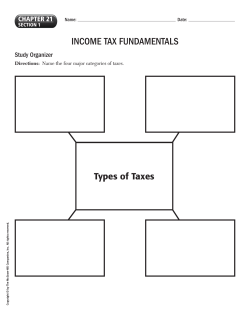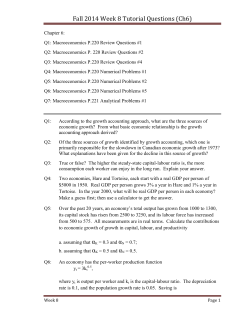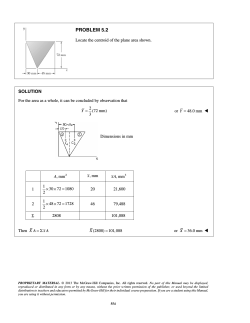
C t
Chapter 12 Consumption and Saving Copyright 2006 McGraw-Hill Australia Pty Ltd PPTs t/a Macroeconomics 2e by Dornbusch, Bodman, Crosby, Fischer, Startz Slides prepared by Dr Monica Keneley. 12-1 Objectives • Evaluate modern theories of consumption which link lifetime consumption to lifetime income • Consider consumption under uncertainty • Investigate further aspects of consumption behaviour • Explain the Barro-Ricardo problem Copyright 2006 McGraw-Hill Australia Pty Ltd PPTs t/a Macroeconomics 2e by Dornbusch, Bodman, Crosby, Fischer, Startz Slides prepared by Dr Monica Keneley. 12-2 Chapter Organisation 12.1 The Life-Cycle–Permanent-Income Theory of Consumption and Saving 12.2 Consumption under Uncertainty: the Modern Approach 12.3 Further Aspects of Consumption Behaviour Copyright 2006 McGraw-Hill Australia Pty Ltd PPTs t/a Macroeconomics 2e by Dornbusch, Bodman, Crosby, Fischer, Startz Slides prepared by Dr Monica Keneley. 12-3 12.1 Consumption and Saving • Consumption accounts for more than 61% of aggregate demand. • A simple model of consumption was outlined in Chapter 7. • It assumed that consumption was determined by disposable income in a simple linear relation. (12.1) Copyright 2006 McGraw-Hill Australia Pty Ltd PPTs t/a Macroeconomics 2e by Dornbusch, Bodman, Crosby, Fischer, Startz Slides prepared by Dr Monica Keneley. 12-4 12.1 The Life-Cycle Theory • Life-cycle (LC) hypothesis – Individuals plan their consumption and savings behaviour over long periods with the intention of allocating consumption over their entire lifetime. • A key assumption is individuals choose to consume at about the same level every period. • This implies that the MPC will vary over the life-cycle of the individual. Copyright 2006 McGraw-Hill Australia Pty Ltd PPTs t/a Macroeconomics 2e by Dornbusch, Bodman, Crosby, Fischer, Startz Slides prepared by Dr Monica Keneley. 12-5 The Life-Cycle Theory • Modern consumption theories consider the way in which individuals plan and make choices over an extended period of time. • Two theories explain consumption patterns: – The life-cycle hypothesis – The permanent income theory. • These two models focus on different aspects of consumption planning. • Today, these two theories have largely merged. Copyright 2006 McGraw-Hill Australia Pty Ltd PPTs t/a Macroeconomics 2e by Dornbusch, Bodman, Crosby, Fischer, Startz Slides prepared by Dr Monica Keneley. 12-6 The Life-Cycle Theory • Example – Assume a person starts work at 20, plans to work until they are 65, expects to die at 80, and earns – $30 000 a year (YL). – The person’s lifetime resources would be YL times working life (WL) or $30 000 (65 – 20) = $1.35m. – Spreading the lifetime resources over the lifespan (NL) gives an annual C of $22 500. – C = (WL/NL) YL = $1.35m/(80 – 20) = $22 500 Copyright 2006 McGraw-Hill Australia Pty Ltd PPTs t/a Macroeconomics 2e by Dornbusch, Bodman, Crosby, Fischer, Startz Slides prepared by Dr Monica Keneley. 12-7 The Life-Cycle Theory • Example – C = (WL/NL) YL – So the MPC is WL/NL = (65 – 20)/(80 – 20) = 0.75 • Consider now a permanent increase in Y of $3000: – The extra Y times 45 working years spread over 60 years of life would increase annual consumption by +$3000 (45/60) = +$2250 – The MPC out of permanent Y would still be: WL/NL = 45/60 = 0.75 Copyright 2006 McGraw-Hill Australia Pty Ltd PPTs t/a Macroeconomics 2e by Dornbusch, Bodman, Crosby, Fischer, Startz Slides prepared by Dr Monica Keneley. 12-8 The Life-Cycle Theory • Consider now a transitory increase in Y of $3000 for 1 year only: – The extra Y spread over 60 years would increase annual consumption by +$3000 (1/60) = +$50 – The MPC out of transitory Y would be 1/NL = 1/60 = 0.017 – The MPC out of permanent Y is large while the MPC out of transitory Y is small. Copyright 2006 McGraw-Hill Australia Pty Ltd PPTs t/a Macroeconomics 2e by Dornbusch, Bodman, Crosby, Fischer, Startz Slides prepared by Dr Monica Keneley. 12-9 Permanent-Income Theory • The Permanent-Income hypothesis (PIH) claims C is not related to current Y but rather longer-term estimates of Y. • Permanent-Income is: – The steady rate of C a person could maintain for the rest of his or her life – Given the present level of wealth and the Y earned now and in the future. Copyright 2006 McGraw-Hill Australia Pty Ltd PPTs t/a Macroeconomics 2e by Dornbusch, Bodman, Crosby, Fischer, Startz Slides prepared by Dr Monica Keneley. 12-10 Permanent-Income Theory • This implies that consumption is proportional to permanent Y. • C = cYP (12.2) • Where YP is permanent (disposable) Y. • Transitory Y is assumed not to have any substantial affects on consumption. Copyright 2006 McGraw-Hill Australia Pty Ltd PPTs t/a Macroeconomics 2e by Dornbusch, Bodman, Crosby, Fischer, Startz Slides prepared by Dr Monica Keneley. 12-11 Chapter Organisation 12.1 The Life-Cycle–Permanent-Income Theory of Consumption and Saving 12.2 Consumption under Uncertainty: the Modern Approach 12.3 Further Aspects of Consumption Behaviour Copyright 2006 McGraw-Hill Australia Pty Ltd PPTs t/a Macroeconomics 2e by Dornbusch, Bodman, Crosby, Fischer, Startz Slides prepared by Dr Monica Keneley. 12-12 12.2 Consumption under Uncertainty: the Modern Approach • The modern version of the LC-PIH links income uncertainty and changes in consumption. • Changes is consumption arises from surprise changes in Y. • Without surprises, maximising consumers equate consumption over all periods. Copyright 2006 McGraw-Hill Australia Pty Ltd PPTs t/a Macroeconomics 2e by Dornbusch, Bodman, Crosby, Fischer, Startz Slides prepared by Dr Monica Keneley. 12-13 Consumption under Uncertainty: the Modern Approach • Any reallocation of consumption from the optimum will reduce total utility. • A person enjoys utility u from consumption C in period t: u(Ct). • Lifetime utility (LU) is the sum of period-by-period utilities. Copyright 2006 McGraw-Hill Australia Pty Ltd PPTs t/a Macroeconomics 2e by Dornbusch, Bodman, Crosby, Fischer, Startz Slides prepared by Dr Monica Keneley. 12-14 Consumption under Uncertainty: the Modern Approach – Starting at period t until the final period T LU = u(Ct) + u(Ct + 1) + ….. + u(CT - 1) + u(CT) • The lifetime budget constraint (LBC) is the sum of the period-by-period consumption LBC = Ct + Ct + 1 + ….. + CT - 1 + CT = wealth +YLt +YLt+1 + …..+YLT - 1+YLT Copyright 2006 McGraw-Hill Australia Pty Ltd PPTs t/a Macroeconomics 2e by Dornbusch, Bodman, Crosby, Fischer, Startz Slides prepared by Dr Monica Keneley. (12.3) 12-15 Consumption under Uncertainty: the Modern Approach • Equation 12.3 states that consumers choose consumption each period: – To maximise lifetime utility – Subject to total lifetime resources. • The optimal choice is the C path that equates the marginal utility of C across periods: – MU(Ct + 1) = MU(Ct) – No reallocation over time can increase total utility. Copyright 2006 McGraw-Hill Australia Pty Ltd PPTs t/a Macroeconomics 2e by Dornbusch, Bodman, Crosby, Fischer, Startz Slides prepared by Dr Monica Keneley. 12-16 Consumption under Uncertainty: the Modern Approach • Now consider uncertainty. – Future marginal utility is unknown at time t. – The consumer must estimate the expected value of tomorrow’s t + 1 utility: E [MU(Ct + 1)]. – The optimum time path of consumption is where E[MU(Ct + 1)] = MU(Ct). – If the (marginal) utility function is one-to-one with C, then: E (Ct + 1) = Ct. Copyright 2006 McGraw-Hill Australia Pty Ltd PPTs t/a Macroeconomics 2e by Dornbusch, Bodman, Crosby, Fischer, Startz Slides prepared by Dr Monica Keneley. 12-17 Consumption under Uncertainty: the Modern Approach • Now consider uncertainty. – E (Ct + 1) = Ct – If observed C is expected C with a random surprise Ct + 1 = E (Ct + 1) + – Then substituting for the expected value derives a simple random-walk model of consumption Ct + 1 = E (Ct + 1) + = Ct + Copyright 2006 McGraw-Hill Australia Pty Ltd PPTs t/a Macroeconomics 2e by Dornbusch, Bodman, Crosby, Fischer, Startz Slides prepared by Dr Monica Keneley. 12-18 Consumption under Uncertainty: the Modern Approach • The random walk model suggests that changes in consumption should not be predictable. • Consumption is assumed to be based on future expected income as well as current income. • The predictions of the random walk model appear to be fairly accurate. Copyright 2006 McGraw-Hill Australia Pty Ltd PPTs t/a Macroeconomics 2e by Dornbusch, Bodman, Crosby, Fischer, Startz Slides prepared by Dr Monica Keneley. 12-19 LC–PIH: The Traditional Model Strikes Back • Empirical evidence suggests: – Both the simple consumption function and the LC–PIH help explain consumption behaviour. – Campbell and Mankiw (1989) found that 1/3 of household consumption can be explained by current Y rather than permanent Y. – Consumption behaviour exhibits excess sensitivity (C responds strongly to predictable changes in Y) and excess smoothness (C responds sluggishly to surprise changes in Y). Copyright 2006 McGraw-Hill Australia Pty Ltd PPTs t/a Macroeconomics 2e by Dornbusch, Bodman, Crosby, Fischer, Startz Slides prepared by Dr Monica Keneley. 12-20 Liquidity Constraints and Myopia • Why doesn’t LC–PIH fully explain consumption behaviour? • Three reasons may account for this shortfall: – Liquidity constraints – Myopia – Uncertainty and buffer stock saving. Copyright 2006 McGraw-Hill Australia Pty Ltd PPTs t/a Macroeconomics 2e by Dornbusch, Bodman, Crosby, Fischer, Startz Slides prepared by Dr Monica Keneley. 12-21 Liquidity Constraints and Myopia • Liquidity constraints – Represent constraints on borrowing – A consumer may not be able to borrow to sustain current consumption in the expectation of higher future Y – Example: Students cannot obtain a large loan now merely on the basis of expected higher future Y. Copyright 2006 McGraw-Hill Australia Pty Ltd PPTs t/a Macroeconomics 2e by Dornbusch, Bodman, Crosby, Fischer, Startz Slides prepared by Dr Monica Keneley. 12-22 Liquidity Constraints and Myopia • Myopia – Consumers may not be as forward looking as suggested by the LC–PIH – They take a short-sighted approach – Example: An announcement that social security benefits will be increased in 6 weeks' time – Doesn’t increase consumption (until benefits are paid) because the recipients do not have the available assets to increase consumption (liquidity constraint), or – They do not pay attention to the announcement (myopia), or they don’t believe it. Copyright 2006 McGraw-Hill Australia Pty Ltd PPTs t/a Macroeconomics 2e by Dornbusch, Bodman, Crosby, Fischer, Startz Slides prepared by Dr Monica Keneley. 12-23 Uncertainty and Buffer-Stock Saving • Some saving is precautionary (buffer-stocks) to guard against times when income is low. – Y fluctuations create considerable risk for the consumer. – The pain caused by a large drop in spending is greater than the pleasure caused by an equal-size increase in spending. – Consumers may avoid having to cut C sharply in bad times if they have a buffer-stock. Copyright 2006 McGraw-Hill Australia Pty Ltd PPTs t/a Macroeconomics 2e by Dornbusch, Bodman, Crosby, Fischer, Startz Slides prepared by Dr Monica Keneley. 12-24 Chapter Organisation 12.1 The Life-Cycle-Permanent-Income Theory of Consumption and Saving 12.2 Consumption under Uncertainty: the Modern Approach 12.3 Further Aspects of Consumption Behaviour Copyright 2006 McGraw-Hill Australia Pty Ltd PPTs t/a Macroeconomics 2e by Dornbusch, Bodman, Crosby, Fischer, Startz Slides prepared by Dr Monica Keneley. 12-25 12.3 Further Aspects of Consumption Behaviour • The Barro-Ricardo Problem (Ricardian equivalence) – Claims that a reduction in taxes does not increase consumption. – Households save the additional disposable income, with unchanged consumption spending. – Debt financing of the budget deficit by bond issue will require future increases in taxes. – So households increase their savings now to pay for the future tax increase. Copyright 2006 McGraw-Hill Australia Pty Ltd PPTs t/a Macroeconomics 2e by Dornbusch, Bodman, Crosby, Fischer, Startz Slides prepared by Dr Monica Keneley. 12-26 Further Aspects of Consumption Behaviour • Objections to the Ricardian equivalence – People have finite lives, so later generations pay for the debt that the present generation enjoys. – For a given tax cut now, people increase their consumption now, as the tax cut eases their liquidity constraints. – They do not save now for the future increase in taxes as their liquidity constraints imply they are consuming less now then their optimal consumption level. Copyright 2006 McGraw-Hill Australia Pty Ltd PPTs t/a Macroeconomics 2e by Dornbusch, Bodman, Crosby, Fischer, Startz Slides prepared by Dr Monica Keneley. 12-27 International Differences in Savings Rates • Gross national savings – The sum of private sector and public sector savings. • Public sector savings – Includes total government saving and savings of public sector enterprises and financial institutions. • Private sector savings – Includes personal (household) and business savings. Copyright 2006 McGraw-Hill Australia Pty Ltd PPTs t/a Macroeconomics 2e by Dornbusch, Bodman, Crosby, Fischer, Startz Slides prepared by Dr Monica Keneley. 12-28 International Differences in Savings Rates Copyright 2006 McGraw-Hill Australia Pty Ltd PPTs t/a Macroeconomics 2e by Dornbusch, Bodman, Crosby, Fischer, Startz Slides prepared by Dr Monica Keneley. 12-29 International Differences in Savings Rates • From Figure 12.5: – Significant declines in both private and public sector savings in the early 1990s contributed to national savings reaching a post-war low of around 15.5% of GDP in late 1992. – Since then, national savings has increased to 18.9% of GDP. – This has been entirely due to increased public savings. – Private savings have continued to decline. Copyright 2006 McGraw-Hill Australia Pty Ltd PPTs t/a Macroeconomics 2e by Dornbusch, Bodman, Crosby, Fischer, Startz Slides prepared by Dr Monica Keneley. 12-30 International Differences in Savings Rates Copyright 2006 McGraw-Hill Australia Pty Ltd PPTs t/a Macroeconomics 2e by Dornbusch, Bodman, Crosby, Fischer, Startz Slides prepared by Dr Monica Keneley. 12-31 International Differences in Savings Rates • Table 12.1 shows that Australia had an average gross national savings rate in the 1990s of 18.5%. • This rate is similar to Canada’s (17.5%). • This rate is higher than the rates for the US (16.5%) and the UK (15.7%). • However, national saving is considerably lower than Japan’s (31%). Copyright 2006 McGraw-Hill Australia Pty Ltd PPTs t/a Macroeconomics 2e by Dornbusch, Bodman, Crosby, Fischer, Startz Slides prepared by Dr Monica Keneley. 12-32 International Differences in Savings Rates • What underlies the trend of savings in Australia and internationally? – Large budget deficits imply reduced saving in the public sector. – Changing demographics (such as a larger senior citizen population) account for some of the changes in saving rates over time. – Australia and other OECD economies find it easier to borrow than most other nations. Copyright 2006 McGraw-Hill Australia Pty Ltd PPTs t/a Macroeconomics 2e by Dornbusch, Bodman, Crosby, Fischer, Startz Slides prepared by Dr Monica Keneley. 12-33
© Copyright 2025









